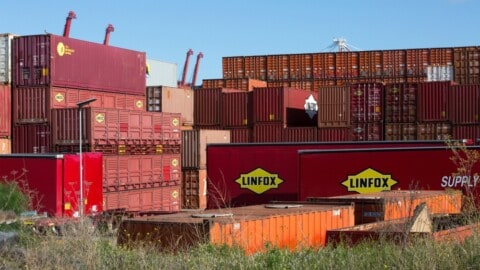According to an expert from the University of New South Wales (UNSW), reducing materials embodied carbon in the construction industry will advance Australia’s goals of a low-carbon future.
It’s hard to drive through any urban area and not notice the busy construction sites on almost every block. Whether it’s a new apartment complex, your neighbours renovating their home, or the new road that’s being marked out – the building and construction industry in Australia isn’t showing signs of slowing down.
But with all growth, comes its own set of challenges.
As Australia sets its eyes on lowering emissions to meet its Paris Agreement target, the complete picture of carbon emissions from Australia’s active construction industry might not be fully clear.
Construction’s embodied carbon represents the carbon dioxide emissions released into the atmosphere before and during construction – including any emissions concerning manufacturing and transportation of the materials used for construction.
In October 2023, the New South Wales Government released the State Environmental Planning Policy which encourages the design and construction of more sustainable buildings across New South Wales to help meet climate change targets.
The building sector in Australia is responsible for one-fifth of all emissions. Concrete, steel, and aluminium contribute to nearly 70 per cent of Australia’s building’s embodied carbon – with levels currently in the millions of tonnes.
For every kilogram of concrete, steel and aluminium produced, approximately 0.2kg, 2.2kg and 20kg of carbon dioxide is emitted, respectively. However, the amount of concrete and steel used in construction dwarfs the aluminium usage.
Sustainable construction expert Dr Ali Kashani from UNSW Civil and Environmental Engineering, said that the construction industry is one of the biggest contributors to Australia’s total emissions but at the same time, it has great potential for decarbonisation through innovation and collaboration among different stakeholders.
“However, embodied carbon is sometimes overlooked in design and construction,
Dr Kashani said.
“We often focus on renewable energy such as solar panels for emissions reduction from the operations side such as heating or cooling buildings and that’s fantastic, but not enough.
“We should also take into account the energy spent and CO₂ emitted during manufacturing and transporting the materials, too.”
Decarbonising construction materials in Australia
Globally, concrete is the second most used material after water and makes up the bulk of Australia’s embodied carbon in construction. With the sheer volume of concrete used in almost all construction projects, including buildings, roads, bridges, and tunnels, this is unlikely to change anytime soon.
Portland cement, a crucial component of concrete, is produced through an energy-intensive process that emits large quantities of CO₂. Similarly, the steel industry heavily relies on coal, a major source of carbon emissions, for its production process.
Steel also comes with significant levels of embodied carbon. According to steel manufacturer InfraBuild, decarbonising the construction industry in Australia requires forward-looking leadership, innovative thinking, new products and industry-wide collaboration.
“InfraBuild is committed to supporting Australia’s shift to a lower carbon emission economy and construction sector, as reflected by our ambitions to be Carbon Neutral by 2030, the manufacturing of our new SENSE 600® lower-embodied carbon construction steel, and ongoing collaboration with our construction partners and research institutions such as UNSW,” said an InfraBuild spokesperson.
Aluminium production, though not much used for construction compared to concrete and steel, is even more energy-intensive and reliant on coal-powered electricity.
The high temperature required for these processes is one of the biggest challenges in decarbonising these industries. Despite current efforts to transition to more sustainable and green energy sources, it requires significantly more investment in this area.
“Unfortunately, not all embodied carbon emissions can be eliminated – but thankfully, it can be reduced,” Dr Kashani said.
“We need to favour renewable energy in any stage of the production process when possible.”
Finding better alternatives
Dr Kashani encouraged manufacturers to look beyond traditional methods for producing their construction materials. He said that using recycled materials as alternative, low-carbon ingredients is an important step the industry can take to reduce its total embodied carbon.
“Steel that was manufactured as a building material but comes to its end-of-life can be recycled to make new steel through electric-arc furnaces which can also be powered by renewable energy.
“Additionally, transitioning from coal to hydrogen as a renewable source could also greatly reduce carbon emissions of steel-making from iron ore – but this technology is still not well developed.
“Materials such as bamboo or engineered timber are fast becoming popular alternatives.
“Similarly, we can partially or completely replace Portland cement with industrial by-products. For example, blast furnace slag, a by-product from steel production, and fly ash from coal power plants have been traditionally used as supplementary cementitious materials to reduce the carbon emission of concrete.
“However, as we transition to renewables, the production of these by-products will be limited in the future with more power plants expected to shut down and new methods of low-carbon steel manufacturing using green hydrogen are favoured.
“So we can’t rely on these as a long-term solution and need to explore the use of other industrial and mining by-products and wastes in concrete.”
Dr Kashani said that low-carbon concrete alternatives such as geopolymer or alkali-activated binders, which do not require Portland cement and limestone calcined clay cement, which requires lower heat for production, are also gaining global attention.
“There’s a start-up company in the United States which claims to produce the first zero-emission cement through an electrolysis process using 100 per cent renewable energy.”
Carbon capturing
Dr Kashani ’s final recommendation to reduce global embodied emissions was through carbon capture and utilisation.
Carbon capturing is a three-step process which involves capturing and cleaning carbon dioxide, transporting it, and then storing it deep underground.
Some critics argue whether carbon capturing ultimately reduces emissions or is instead a licence to ramp them up.
Dr Kashani said that he believes the industry is missing out on opportunities to utilise the captured carbon in other applications.
“We can use this process across many industries such as construction and manufacturing to lower their embodied carbon,” Dr Kashani said.
“For instance, captured CO₂ from steel and cement production can be used to enhance the properties of steel slag and recycled concrete aggregate which also reduces the overall emission of concrete using these recycled materials.
“I think it’s about looking at ways to reduce our overall footprint and change the way we’re thinking about carbon.
“We need to stop thinking about carbon as waste and start looking at it as a by-product that can be re-plugged back into the circular economy.”
Dr Kashani said that switching to renewable energy and alternative materials may not be straightforward for all industries, but that doing nothing about the carbon that is still being emitted should not be an option, either.
“I believe the solution is multi-faceted and carbon capturing and utilisation is currently essential to achieve the net zero target by 2050; at least until a better solution comes around.”
















